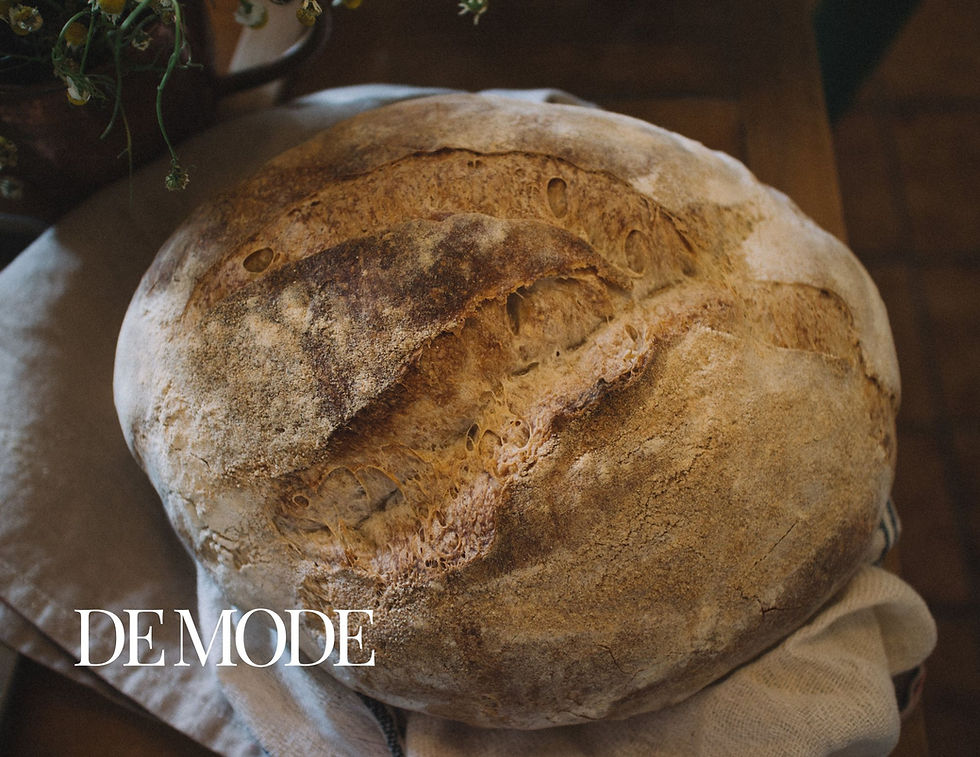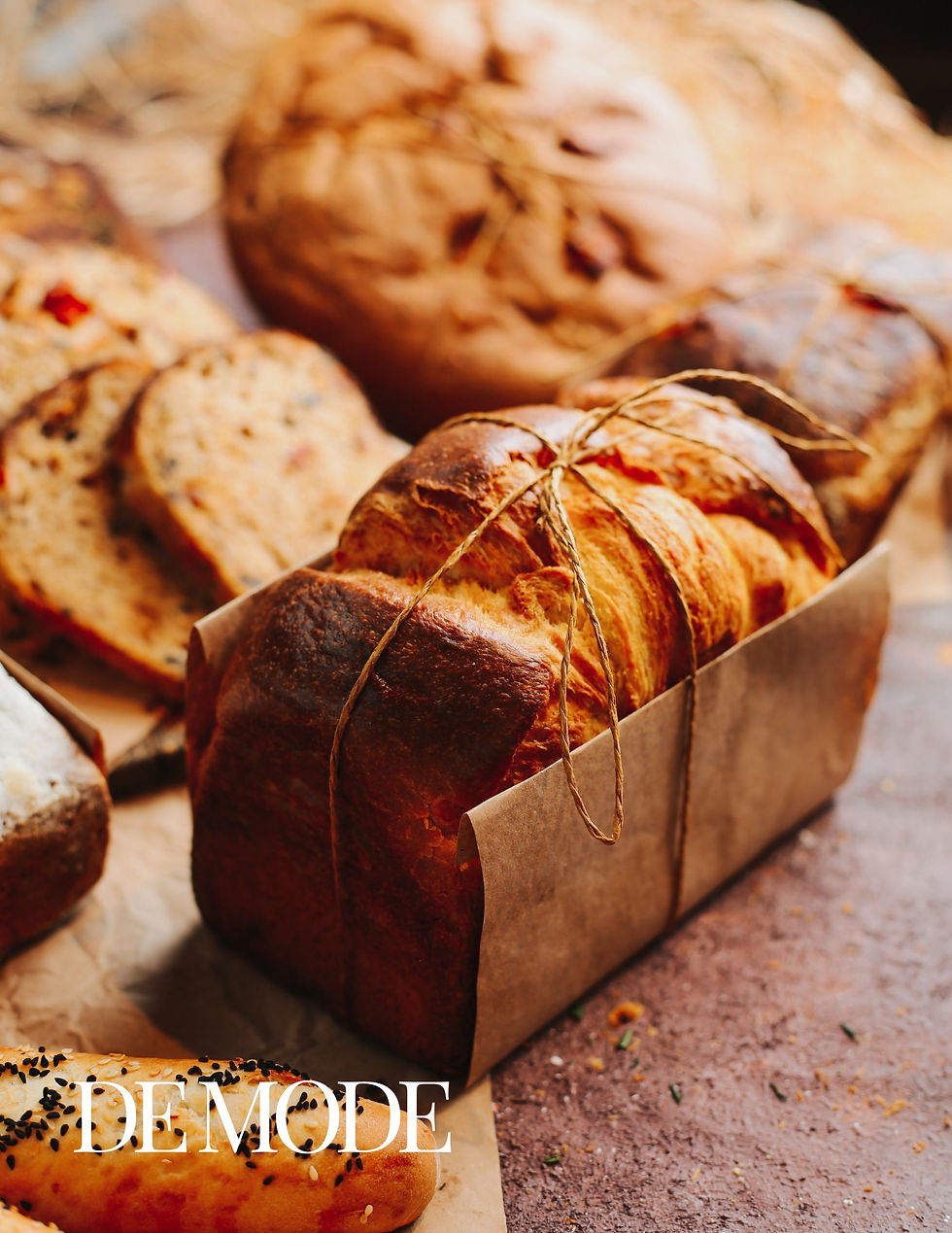ORIGINALLY PUBLISHED IN DE MODE | FOOD
Article Published on: 14TH DEC 2023 | www.demodemagazine.com
Bread, often referred to as the "staff of life," has been a staple in human diets for thousands of years. The process of making bread is not just a culinary endeavor; it is an ancient art form that transcends cultural boundaries. From the robust tang of sourdough to the delicate crispness of a baguette, each type of bread carries its own story and techniques. In this exploration of the art of making bread, we'll delve into the intricate processes behind two iconic varieties: sourdough and baguette.

Sourdough: A Fermented Tradition
Sourdough, with its robust flavor and distinctive chewy texture, represents one of the oldest forms of leavened bread. The magic of sourdough lies in its natural fermentation process, driven by wild yeast and lactic acid bacteria. Crafting a sourdough loaf is a labor of love that requires time, patience, and an understanding of the symbiotic relationship between flour, water, and microbes.
Starter Creation: The heart of sourdough lies in the sourdough starter, a living culture of wild yeast and bacteria. To create a starter, combine equal parts flour and water in a jar and allow it to sit at room temperature. As the mixture attracts wild yeast from the environment, it begins to ferment, developing bubbles and a distinct sour aroma. Regular feeding with fresh flour and water sustains the microbial community, turning the starter into a potent leavening agent.
Mixing and Autolyse: Once the starter is mature, it is mixed with a combination of flour, water, and salt to form the dough. The initial mixing is followed by an autolyse, a resting period that allows the flour to fully hydrate before the intensive kneading begins. This process contributes to the development of gluten, creating the structure that will give the sourdough its characteristic texture.
Bulk Fermentation and Folding: During bulk fermentation, the dough undergoes a series of folds. This technique strengthens the dough and redistributes the wild yeast, promoting even fermentation. The extended fermentation period not only develops the sourdough's flavor but also contributes to its airy crumb and chewy crust.
Shaping and Proofing: After bulk fermentation, the dough is shaped into a boule or batard and left to proof. The proofing stage allows the dough to rise one final time, enhancing its volume and structure. A well-proofed sourdough will exhibit a delicate balance between a soft interior and a crispy crust.
Baking: The final act in the sourdough journey takes place in the oven. Preheated to a high temperature, the oven transforms the dough into a masterpiece. The release of steam at the beginning of baking promotes a crisp crust, while the prolonged heat ensures a fully baked, flavorful interior. The symphony of aromas that fills the kitchen during baking is a testament to the alchemical process of turning humble ingredients into a sublime loaf of sourdough.

Baguette: The French Elegance
In contrast to the slow fermentation of sourdough, the baguette is a testament to the precision and finesse of French baking. Its iconic elongated shape and crispy crust make it a symbol of culinary elegance. Crafting the perfect baguette requires meticulous attention to detail and an understanding of the interplay between ingredients and technique.
Poolish Starter: The baguette begins with a pre-ferment called a poolish. This mixture of flour, water, and a small amount of commercial yeast ferments for several hours, imbuing the dough with a complex flavor profile. The poolish serves as a bridge between the quick fermentation of commercial yeast and the depth of flavor associated with longer sourdough fermentation.
Mixing and Bulk Fermentation: Once the poolish is ready, it is combined with additional flour, water, salt, and commercial yeast to form the baguette dough. The mixing process is brief, avoiding overdevelopment of gluten, which could result in a tough texture. The bulk fermentation that follows allows the dough to rise and develop flavor, albeit in a shorter time frame compared to sourdough.
Dividing and Shaping: After bulk fermentation, the dough is divided into individual portions and shaped into the signature slender baguette form. This process requires a delicate touch to avoid degassing the dough, preserving the air pockets that contribute to the baguette's light, airy crumb.
Proofing: The shaped baguettes undergo a final proofing, during which they rise and develop their distinctive shape. The proofing stage is crucial for achieving the desired balance between an open crumb and a thin, crisp crust.
Scoring and Baking: Before baking, the baguette is scored, creating decorative slashes that help control the dough's expansion during baking. The oven's high temperature and steam contribute to the baguette's characteristic golden-brown crust and tender crumb. Achieving the perfect balance between a thin, crispy exterior and a soft, flavorful interior is the hallmark of an expertly baked baguette.

Conclusion
The art of making bread, whether through the slow fermentation of sourdough or the precision of crafting a baguette, is a testament to the rich tapestry of culinary traditions around the world. Each step in the bread-making process, from starter creation to final baking, represents a dance between science and intuition, patience and precision. Whether you find solace in the tangy embrace of a sourdough loaf or appreciate the elegant simplicity of a baguette, the art of making bread is a timeless craft that continues to captivate and nourish generations. As you embark on your own bread-making journey, may the aroma of freshly baked bread fill your kitchen, and the joy of creation warm your heart and home.